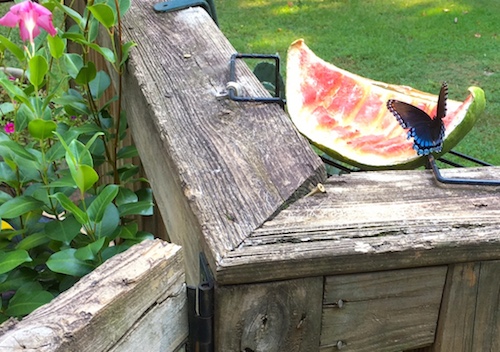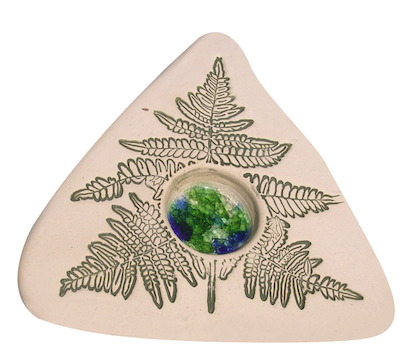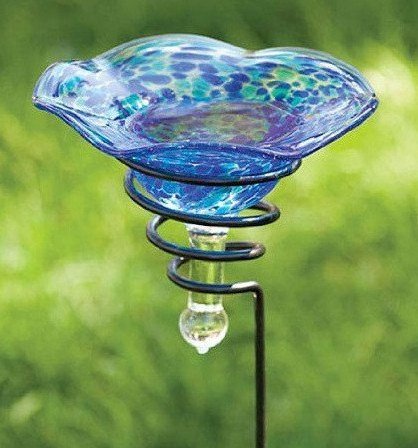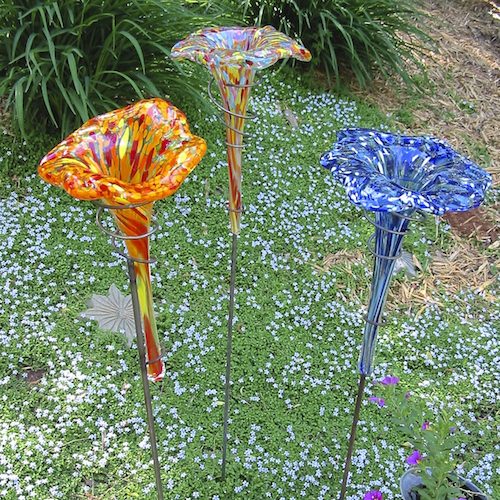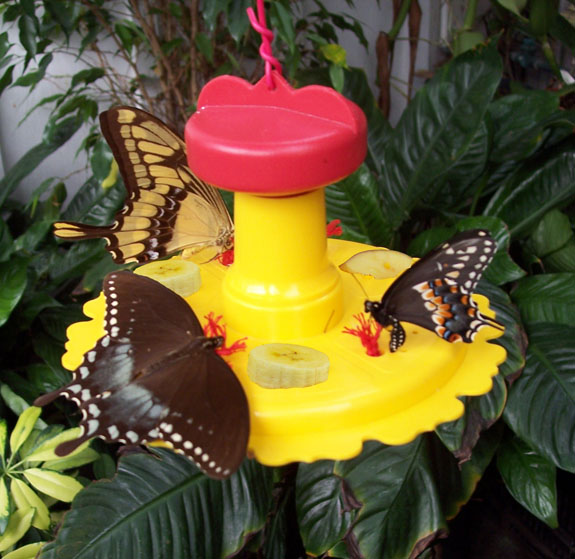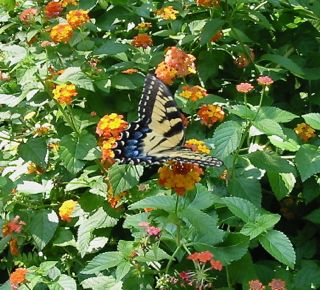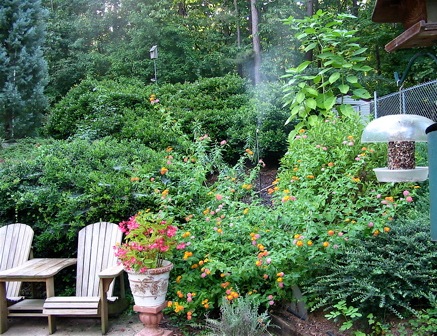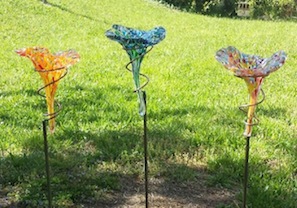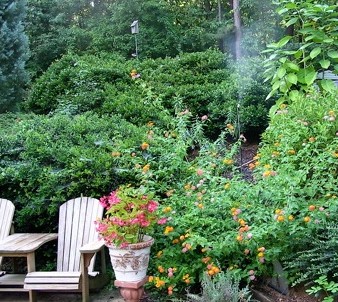-
Fancy Butterfly Feeders not Required
Migratory winged ones are on the move!
It’s an awesome time of year to catch the action not only of feathered friends- but butterflies too!
Although we’ve nary seen a monarch this year (so very sad) a few other butterfly species have been prevalent. Several Swallowtails, Sulphurs and Viceroys to name a few. And even though we have a great selection on our website… they’re not coming to any fancy butterfly feeders.
A few alternative options to actual butterfly feeders:
•Discarded fruit- provided it’s not too far gone
•Nectar producing flowers- preferably native
•Leaf mistersThese things absolutely work to entice the flying jewels! Leaf misters offer a gentle spray which butterflies adore, you can see them dance and flit through the fine mist. In fact, it’s almost mesmerizing! Their own personal spa, leaf misters also have gardens growing lush. Use these year after year, ours are going on their 10th season!
Discarded fruit is a no-brainer; from oranges, to melons, pears, apples and bananas, place fruit on a deck rail, plate, or anywhere near flowers where you’ve seen the least bit of butterfly activity.
And the flowers? We prefer native perennials. Again, you’ll get year after year of blooms and activity. Lantana is is one of the more common plants in the southeast, in fact it’s almost invasive! Butterfly or milk weed is also a popular host plant. Pollination Trifecta in this video with hummingbird, bees and butterflies on one plant!
Plan next spring with a few vegetables specifically for butterfly host plants; dill, fennel and parsley are ideal plants to host black swallowtails, and milkweed is a must for monarch caterpillars!
Another easy DIY is creating a waterless pond for butterflies to warm in the sun. Simply place heat-aborbing rocks (so they’re flat) in a sunny spot, add sand and salt and keep moist. You may wish to line the area first with plastic to keep salt out of soil. Sort of a crude version of the popular butterfly puddlers.
And one last tip on feeding butterflies: They do not drink from an open water source. When using butterfly feeders like this staked one below, place a sponge in the center to soak up nectar. This acts as a wick where butterflies draw nectar like they do in nature from flowers.
Ok, maybe we’re wrong, the really really last tip: Stop using chemicals like pesticides, fertilizers and herbicides. Natural is the new landscape, manicured, pristine lawns and gardens are a thing of the past. Do it for butterflies, do it for all pollinators, most of all… do it for the human race!
-
Butterfly Feeders for Unique Garden Accents and Monarchs
Buzz about the Monarch’s dwindling population is more than justified. You may have heard about it, but if not check this fact: Since the mid-90’s their decline has reached 90% from the 20-year average. What’s this mean in terms of real numbers? Swap monarchs for people for a second, every person in the US would be gone except for those living in just two states!
One of the biggest reasons for their decline is believed to be the disappearance of milkweed- the Monarch caterpillar’s only food source, and also the only plant on which Monarchs will lay their eggs. To name a few other culprits; urban sprawl, extreme weather, new farming practices and illegal logging in the butterflies’ winter habitat in Mexico.
Offering suitable habitat and butterfly feeders really does help the local Monarch population. Don’t bother with houses… they don’t use them! Both can be fantastic and unique garden accents – with feeders being much more useful. Butterflies also adore leaf misters, set one up near lantana or any other nectar-producing plant and you’re bound to see some winged action!
The butterfly feeders above are handmade, blown glass flowers on a 36-inch stake. They’re versatile for nectar or fruit, and for songbirds too. The hanging butterfly feeder below has been tested and approved by butterfly experts. A special combination of wicks and tubes mimic real flower blossoms, the design and color attracts butterflies and the nectar reservoir size is ideal to minimize spoilage.
This season, Swallowtails have been spotted in our butterfly habitat, but no Monarchs yet 🙁 Still a few months for their presence in the southeast… we’ll continue to feed and keep watch for the winged wonders!
-
Use Puddlers as Butterfly Feeders too!
Gift idea #22: Prompt a butterfly haven
What gardener or birding enthusiast doesn’t adore butterflies? If they’re fairly new to either hobby, the first point of concern is habitat, even if they happen to be seasoned vets… habitat is always key in luring any winged wonders to the garden!
Food, water and shelter simply equal habitat, not too complicated at all. When landscaping a new home, or enhancing existing gardens, native plants are always the best choice, for wildlife and the home-owner. As food sources and as shelter, they’re more likely to thrive in local soils. Nectar-producing flowers (including many of the showy annuals) are really butterfly feeders themselves.
Butterfly houses? Although they make for stunning garden accents with an almost magical appeal… we’re not convinced butterflies actually use them! But another cool butterfly feeder is hand-blown and home grown right here in Georgia. On a tall stake, these large glass flowers offer versatility for feeding nectar as well. Birds will use them as sippers with fresh water, and even suet or jelly for migratory friends works great! Best of all, these are lovely in the garden whether butterflies are present or not!
Creating those spaces for butterflies with water and places to “warm in the sun” is the absolute equivalent to visiting the spa! Leaf misters are a major attraction,
and birds love them too! Puddlers are perfect as feeders using over ripe fruit or the secret sauce recipe on the tag accompanying them. As an inviting bath for butterflies, they’re simple to use.
Handcrafted weather-proof stoneware, the decorative plaque-like puddlers are safe in the garden year-round, adding a nice touch even when flying jewels are absent. A great gift for any nature buff, ours come with a book on butterfly gardening for ideas and inspiration on creating the ultimate habitat!

